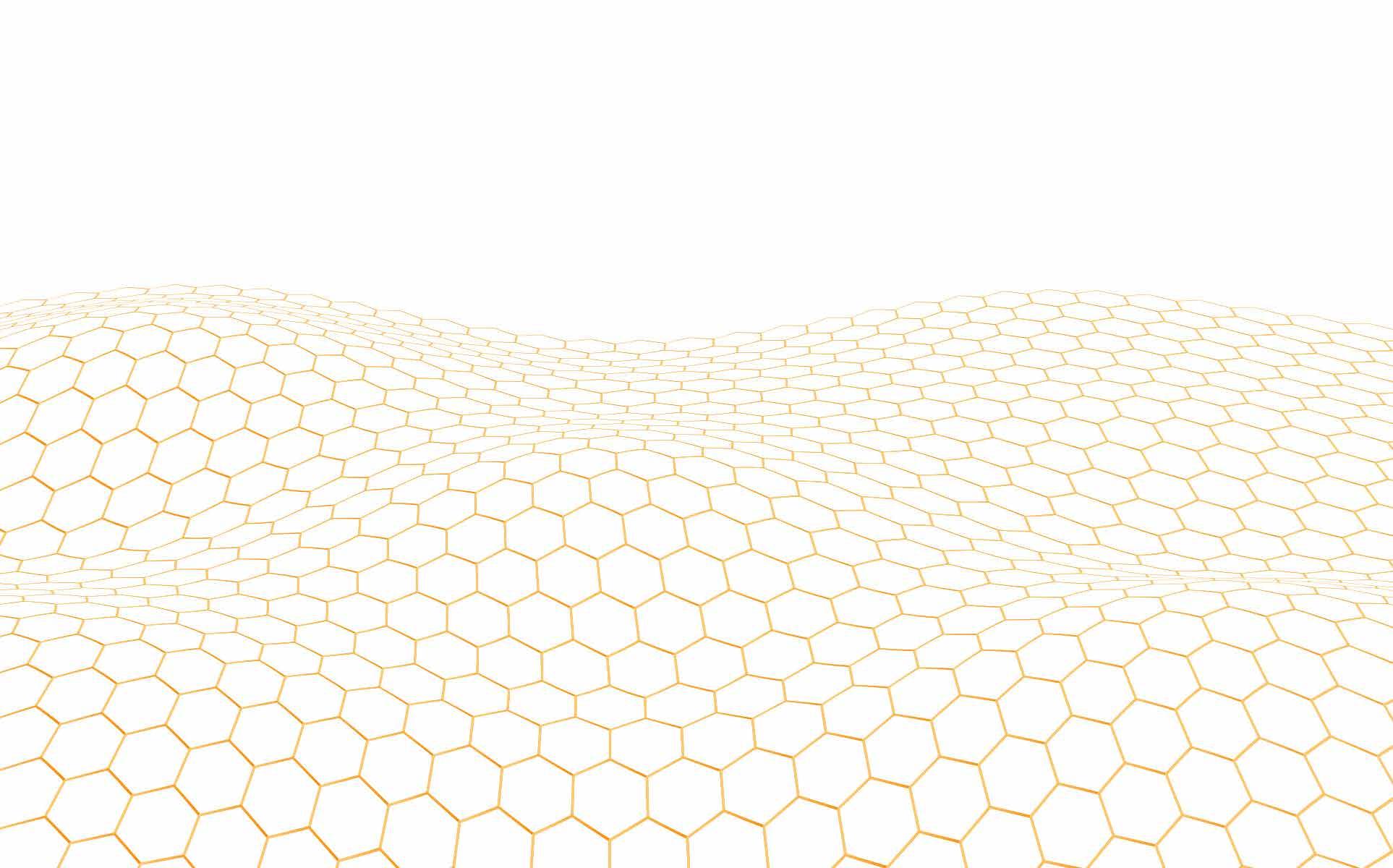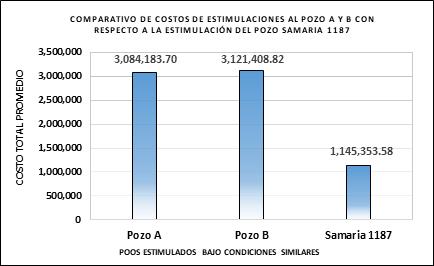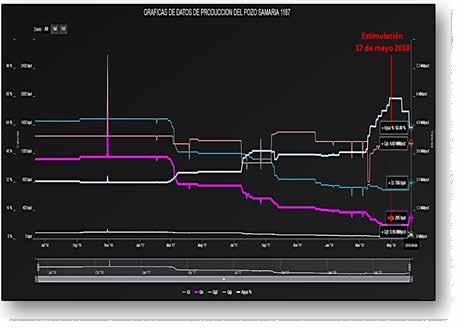
6 minute read
Estimulación

Estimulación matricial mixta energizada con WCP-1
Por / By : Israel Arias González, Nemesio Miguel Hernández; José Elizalde Pérez y Guillermo Guillot Merchand
El estudio abordó la estimulación matricial mixta energizada con el Sistema Well Clean Premium 1 (WCP-1), un agente estimulante de alta reactividad.
La producción del Activo Integral de Producción Bloque S02, proviene en su mayoría de campos maduros cuya presión de yacimiento ha declinado con el tiempo; aunado al daño de la formación, hace que sea más difícil la extracción de los hidrocarburos desde el yacimiento hasta los tanques de almacenamiento.
Lo que conlleva a realizar tratamientos de estimulación para la remoción de ese daño y la utilización de sistemas artificiales de producción; para contrarrestar las contrapresiones en líneas de descarga y cabezales de recolección de los pozos, generando un incremento en los costos de producción.
Esta situación se ve agravada por el hecho de que, durante la fase productiva de los pozos, se presentan problemas de depósitos orgánicos con viscosidades relativamente altas; problemas por alto corte de agua lo que provoca incrustaciones de carbonatos; lo que puede ocasionar un daño a la formación debido al obturamiento del espacio poroso.
El objetivo de este trabajo buscó presentar los resultados obtenidos de la aplicación de estimulación matricial mixta energizada con el Sistema Well Clean Premium 1 (WCP-1); Agente estimulante de alta reactividad aplicada en el campo Samaria en el pozo Samaria 1187.
En los cuales se observaron incrementos de producción y sostenimiento de la misma, durante el periodo de la aplicación tecnológica; bajo el procedimiento de documentación de mejores prácticas de la Gerencia de Aseguramiento Tecnológico de Exploración y Producción (GATEP) de Pemex.
Respecto al comportamiento operativo de los parámetros de presión y gasto de inyección monitoreados en tiempo real; se determinó que la formación ofreció una resistencia normal a los sistemas reactivos, la presión siempre en pendiente positiva, indica la reactividad del sistema.
De acuerdo con las condiciones de gastos de inyección en rangos programados por diseño, se observa control en el tratamiento con la ayuda de
Mixed matrix stimulation energized with WCP-1
The study addressed mixed matrix stimulation energized with the Well Clean Premium 1 System (WCP-1), a highly reactivity stimulating agent.
The production of the Integral Production Asset Block S02, comes mostly from mature fields whose deposit pressure has declined over time; coupled with the damage of the formation, it makes it more difficult to extract hydrocarbons from the reservoir to the storage tanks.
This entails stimulation treatments for the removal of such damage and the use of artificial production systems; counteracting dams on discharge lines and well collection heads, leading to an increase in production costs.
This situation is aggravated by the fact that, during the production phase of wells, there are problems of organic deposits with relatively high viscosities; problems of high water cutting which causes carbonate inlays; which can cause damage to formation due to the sealing of porous space.
The objective of this work sought to present the results obtained from the application of mixed matrix stimulation energized with the Well Clean Premium 1 System (WCP-1); High reactivity



la energización con nitrógeno; ya que no hubo gran variación en las presiones hidrostáticas de la fase líquida.
Las caídas friccionales observadas en el gasto de inyección fueron constantes, solo variaciones leves en los cambios de etapa y fluido líquidos. Durante el periodo de inyección del solvente, se tuvo un decremento de presión en cabeza por su diferencia en magnitud de presión hidrostática; respecto a la columna con nitrógeno inicial.
La cédula de inyección en tiempo real tuvo una similitud con la cédula de inyección diseñada; por lo cual se asegura la penetración programada de los sistemas reactivos.
El radio de invasión diseñado estuvo en función de la eficiencia en la ejecución del tratamiento programado, respetando en todo momento la cédula de inyección diseñada; del control de la posible divergencia por la presencia de dos intervalos disparados, en este caso, a gastos de inyección constante en líquido y variable en nitrógeno.
Los resultados de las pruebas de laboratorio fueron satisfactorios; el diseño se cumplió en un alto porcentaje en la operación y el intervalo estimulado mostró aceptación de fluido en todo momento.
La estrategia mostró reactividad y el uso de nitrógeno optimizó los resultados finales en productividad y limpieza de productos de reacción.
Es necesario programar el uso de estranguladores de acuerdo con el comportamiento del yacimiento; cuidando la estabilidad de la presión e identificando en todo momento los fluidos producidos y su pH.
De acuerdo con el estudio, es imprescindible aprovechar al máximo el potencial productivo remanente del yacimiento estimulado cuidando precisamente estas fases de limpieza e inicio de producción.
Se puede prever una producción longeva cuidando todos los detalles que se estipulan en los procedimientos de estimulación, limpieza y producción.
En relación con el incremento de la producción el pozo Samaria 1187 mostró un incremental de 150 barriles por día (bpd); con respecto a la producción del pozo previo a la estimulación 149 bpd lo cual representa un incremento del 103%. stimulating agent applied in the Samaria field in the Samaria 1187 well. In which increases in production and support of production, were observed during the period of technological application; under Pemex’s Technology Exploration and Production Assurance Management (GATEP) best practice documentation procedure. Regarding the operational behavior of the pressure and injection expenditure parameters monitored in real time; it was determined that the formation offered normal resistance to reactive systems, the pressure always on positive slope, indicates the reactivity of the system.
According to the conditions of injection expenses in ranges programmed by design, control is observed in treatment with the help of nitrogen energization; since there was not much variation in the hydrostatic pressures of the liquid phase.
The frictional drops observed in injection expenditure were constant, only slight variations in liquid stage and fluid changes. During the solvent injection period, a pressure decrease was had at the head because of its difference in hydrostatic pressure magnitude; relative to the column with initial nitrogen.
The real-time injection card had a similarity to the designed injection card; this ensures the programmed penetration of reactive systems.
The engineered invasion radius was based on efficiency in the execution of the programmed treatment, respecting at all times the injection card designed; control of the possible divergence by the presence of two intervals triggered, in this case, at constant injection costs into liquid and variable in nitrogen.
Laboratory test results were satisfactory; the design was fulfilled in a high percentage in the operation and the stimulated interval showed fluid acceptance at all times.
The strategy showed reactivity and nitrogen use optimized the final results in productivity and cleaning of reaction products.
It is necessary to program the use of stranglers according to the behavior of the deposit; taking care of the stability of the pressure and identifying at all times the fluids produced and their pH.
According to the study, it is essential to make the most of the remaining productive potential of the stimulated site by taking care of precisely these phases of cleaning and start of production.
Long-lasting production can be foreseen taking care of all the details stipulated in the stimulation, cleaning and production procedures.
In relation to the increase in production the Samaria 1187 well showed an incremental of 150 barrels per day (bpd); with respect to pre-stimulation well production 149 bpd which represents an increase of 103%.




